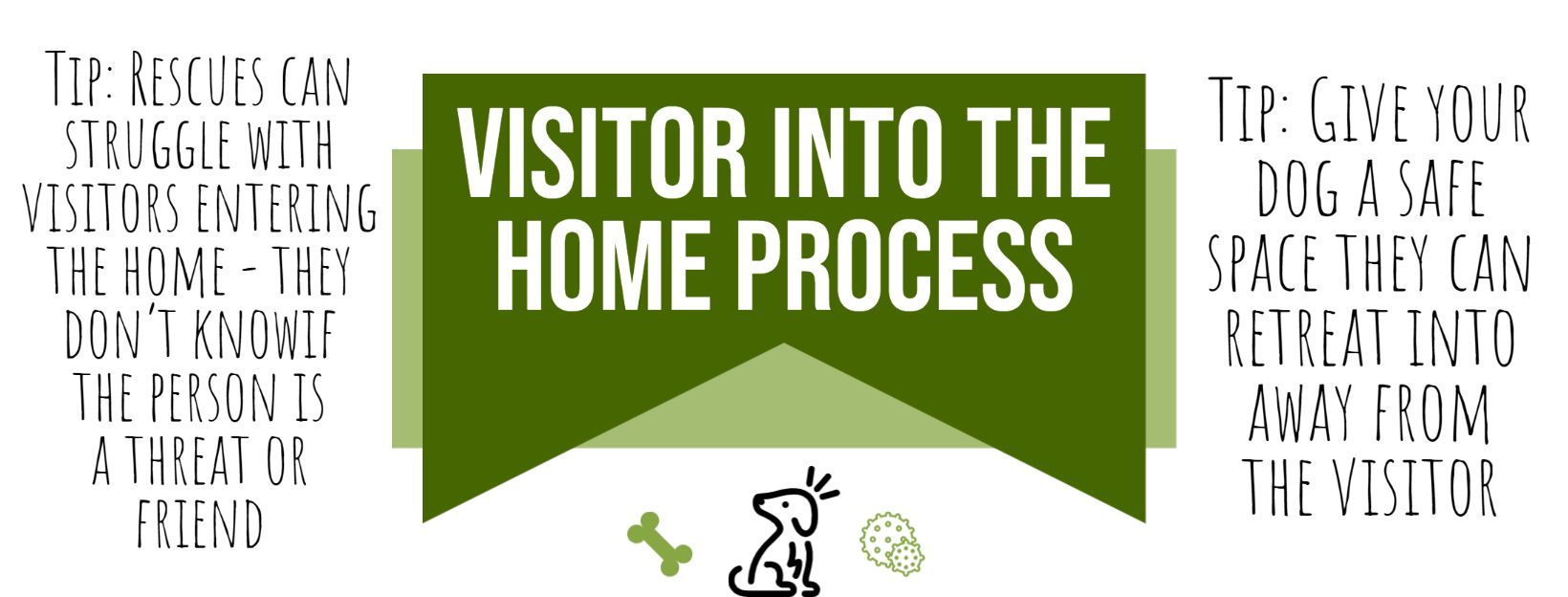
For rescue dogs, strange people coming into their house can be overwhelming and frightening. In order to help the dog adjust to having new people come into their space we have devised a process which allows the dog to interact with visitors on their own terms.
Remember!
- Visitors should NOT be coming for at least a couple of weeks whilst the dog is settling into the home. People turning up and meeting the dog days after they have arrived at the home could really affect their progress!
- Forced interaction could lead to behavioural issues with people visiting the home.
It is advised that you practice this process prior to allowing visitors to come to the home so that you, and all household members are familiar with the process and know what to do when a guest does arrive. All arrivals into the home can be scary for a dog, regardless of who it is so this will also increase their confidence with the household members.
- Before the visitor arrives if possible, but certainly before opening the door to them when they knock, take the dog into another room and close the door. Make sure you have a trailing line on the dog. If the dog is barking, ignore the behaviour and do not punish them for it.
- Answer the door to the visitor and ask them to sit down in the living room/kitchen etc and bring them some treats to give to the dog. Ask them to ignore the dog, avoid eye contact and do not make a fuss of their arrival, tell them that the dog must come over to them and interaction must not be forced, and they should not attempt to touch the dog without you telling them they can.
- Open the door to the room where the dog has been placed and return to the room where your visitor is sat also leaving that door open. Do not pull the dog into the room, let them come and investigate if they want to or take themselves away if they want to. Continue conversations with your guest as normal and ignore the dog.
- If the dog enters the room where the visitor is sat, get them to drop a couple of treats down onto the floor – do not lean down as this could be seen as threatening. If the dog wants to approach, let them. If the dog wants to retreat away from the visitor, let them and do not restrict access/exits or force the dog to interact.
- If the dog comes over for attention from the visitor allow them to pet the dog under the chin or on the chest only as going over the top of the head can scare dogs and could result in snapping, growling, or snarling. Tell them to give attention for no longer than 5 seconds a time – this allows for a ‘natural break’ so the dog can retreat if they wish. If the dog pushes for more fuss, encourage the guest to do so, but offer the dog that natural break otherwise the dog could get overwhelmed. If your dog is especially nervous then you may want to instruct your visitors not to touch your dog at all. Follow advice from how you were introduced to your dog by our staff.
- If the visitor needs to use the bathroom/is about to leave, remove the dog from the room calmly and shut away into another room. Do not allow visitors to stand up and move around the home whilst the dog is in the same room, curled up beside them or sitting at their feet. Once the dog is safely out of the way the visitor can stand up and leave the room. If they intend to come back into the room, follow the above steps.
Remember: The dog needs to bond with the household members first. Many of Oakwood’s rescues have never lived in a home environment before and have had many more negative experiences with people than good. Do not expect them to like the people visiting. This process helps to avoid the dog developing behavioural issues towards people entering the home. It is a contractual agreement that this process is followed for each new person the dog meets. It needs to be repeated over and over again with the same person until the dogs is as confident with them as they are with you (it is still recommended that you continue this process after this too). Do not feel disheartened if it takes 5 times, 10 times or more for the dog to become relaxed around a visitor. Dogs will make associations in their own time, not yours.
Do not allow the visitor to walk into the room where the dog is – this can cause them to panic and react towards the guest. If the exits are blocked the dog could redirect their fear onto the visitor and bite them, snarl at, growl or bark at them. If you require ANY advice, please ask a member of staff!